

by Cathy Schar and Arlin Brown
Trip length 3.8 miles
At River Road head north; turn left on SE Sparrow St. and right on SE 19th ; follow it into Kellogg Creek Park along the Willamette, keeping on the path until you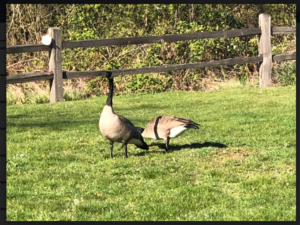 come to the Milwaukie Bay Park parking lot; turn left and follow the sidewalk along the river; proceed to the right side of the bridge over Kellogg Creek to look down at the fish ladder connecting the Willamette to Kellogg Creek; then take a path towards the boat launch into Riverfront Park. For the first side trip, follow the path continuing north to the Klein Point lookout at the confluence of Johnson Creek and the Willamette; leave this area and continuing north, to SE 17th St., crossing McLoughlin Blvd; from 17th, turn right on SE Main through downtown Milwaukie. For the second side trip, at the end of a little grassy area, Dogwood Park, on your right, veer down a dirt path to a small tree-lined viewpoint overlooking Kellogg Creek; return to the sidewalk and cross the covered pedestrian bridge into Robert Kronberg Park; follow the path through the park; cross McLoughlin Blvd. to the Trolley Trail; turn right off the Trolley Trail onto SE 26th Avenue; continue, crossing SE Park St., and at the end of SE 26th is a small path to return to the Trolley Trail; turn right on Silver Springs Road until you cross River Road and are heading back to Rose Villa.
come to the Milwaukie Bay Park parking lot; turn left and follow the sidewalk along the river; proceed to the right side of the bridge over Kellogg Creek to look down at the fish ladder connecting the Willamette to Kellogg Creek; then take a path towards the boat launch into Riverfront Park. For the first side trip, follow the path continuing north to the Klein Point lookout at the confluence of Johnson Creek and the Willamette; leave this area and continuing north, to SE 17th St., crossing McLoughlin Blvd; from 17th, turn right on SE Main through downtown Milwaukie. For the second side trip, at the end of a little grassy area, Dogwood Park, on your right, veer down a dirt path to a small tree-lined viewpoint overlooking Kellogg Creek; return to the sidewalk and cross the covered pedestrian bridge into Robert Kronberg Park; follow the path through the park; cross McLoughlin Blvd. to the Trolley Trail; turn right off the Trolley Trail onto SE 26th Avenue; continue, crossing SE Park St., and at the end of SE 26th is a small path to return to the Trolley Trail; turn right on Silver Springs Road until you cross River Road and are heading back to Rose Villa.
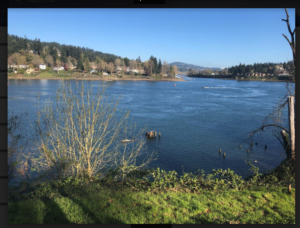 Most of this wonderful jaunt is downhill…yippee! The large cottonwoods and evergreens often reveal a Bald Eagle or Osprey; blooming trees and plants abound. At the end of SE Sparrow is the entrance to Elk Rock Park, the Spring Park Natural Area and Elk Rock Island. We’re told part of Elk Rock Island is open now after being closed because of fire last fall. In April 2016, Portland formally transferred this Island to the City of Milwaukie. Along with the vernal pools, river views, native Pacific Madrone trees and wildflowers, you can look west to Elk Rock itself. Legend has it that Elk Rock is where Native American hunters would herd elk over the cliff to their deaths as in a buffalo jump. Peregrine Falcons nest in these cliffs, neighbors to cliff-nesting Canada geese. (Yes, geese regularly nest off the ground, on building tops and also in old raptor nests.)
Most of this wonderful jaunt is downhill…yippee! The large cottonwoods and evergreens often reveal a Bald Eagle or Osprey; blooming trees and plants abound. At the end of SE Sparrow is the entrance to Elk Rock Park, the Spring Park Natural Area and Elk Rock Island. We’re told part of Elk Rock Island is open now after being closed because of fire last fall. In April 2016, Portland formally transferred this Island to the City of Milwaukie. Along with the vernal pools, river views, native Pacific Madrone trees and wildflowers, you can look west to Elk Rock itself. Legend has it that Elk Rock is where Native American hunters would herd elk over the cliff to their deaths as in a buffalo jump. Peregrine Falcons nest in these cliffs, neighbors to cliff-nesting Canada geese. (Yes, geese regularly nest off the ground, on building tops and also in old raptor nests.)
Walking into Kellogg Creek Park along the river, we’ve seen river otter, a sea lion and various ducks and Canada geese. Fishermen along the bank pull out their lines when the sea lion is cruising around: no reason to give up a nice hooked fish to this large mammal. Speaking of fish, be sure you look down from the east side of the bridge 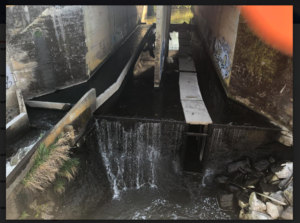 over Kellogg Creek as it joins the Willamette—check out the fish ladder that allows fish to enter Kellogg Creek and continue into Kellogg Lake. No wonder the otters and fish-eating ducks, e.g., Common Mergansers, hang around looking for meals at this confluence site. At the northeastern portion of Riverfront Park,take a side trip on a path to Klein Point Overlook, a tree canopied, partial circle, rock-walled area above Johnson Creek as it empties into the Willamette. Reader boards give historic information, plus you can look down at the water fowl and up at frequent raptors. The historic streetcar crossed at this area. Look down at the creek bank for the concrete pads that supported the old wooden trestle.
over Kellogg Creek as it joins the Willamette—check out the fish ladder that allows fish to enter Kellogg Creek and continue into Kellogg Lake. No wonder the otters and fish-eating ducks, e.g., Common Mergansers, hang around looking for meals at this confluence site. At the northeastern portion of Riverfront Park,take a side trip on a path to Klein Point Overlook, a tree canopied, partial circle, rock-walled area above Johnson Creek as it empties into the Willamette. Reader boards give historic information, plus you can look down at the water fowl and up at frequent raptors. The historic streetcar crossed at this area. Look down at the creek bank for the concrete pads that supported the old wooden trestle.
The Turkey Vultures are back, and you see them cruising the river edges looking for food. TV’s, as we say in bird-shorthand, are noticed from RV at dusk as dozen or so circle above and fly around RV heading south upriver. I’ve seen them roosting on the cliffs near Oregon City. They need to roost on high places—dead trees, towers, cliffs,
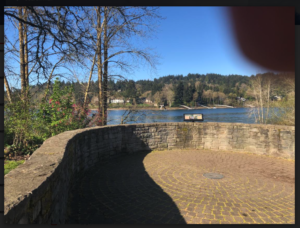 etc. Why? Because they on thermals—rising columns of warm air that are created as the sun’s rays heat the earth. Because thermals are usually weak early in the day, become abundant and strong late in the morning and at mid-day, and then decline late in the afternoon, TVs are rarely active early. And they’re not known to fly at night. A little gee-whiz item: a group of TVs is called a “kettle”(?) Speaking of group names for birds—look for the hummingbirds that commonly are feeding on the native red currant bushes and other spring blooms; a group of these little jewels is called a “pallet”— is that appropriate or what! Makes more sense to me than a “kettle” of TVs, but a group of large black birds circling in a thermal—perhaps kettle like?
etc. Why? Because they on thermals—rising columns of warm air that are created as the sun’s rays heat the earth. Because thermals are usually weak early in the day, become abundant and strong late in the morning and at mid-day, and then decline late in the afternoon, TVs are rarely active early. And they’re not known to fly at night. A little gee-whiz item: a group of TVs is called a “kettle”(?) Speaking of group names for birds—look for the hummingbirds that commonly are feeding on the native red currant bushes and other spring blooms; a group of these little jewels is called a “pallet”— is that appropriate or what! Makes more sense to me than a “kettle” of TVs, but a group of large black birds circling in a thermal—perhaps kettle like?
Other sights along our walk include Dark Horse Comics on Main Street in Milwaukie and a beautiful fish-and-logs mosaic art piece is dazzling inset into the street. If you have time take a quick little second side trip in Dogwood Park— a small grassy area towards the end of Main St. before you go under the MAX trestle leading to the pedestrian bridge into Robert Kronberg Park. See the short split rail fence on your right? It has an opening with 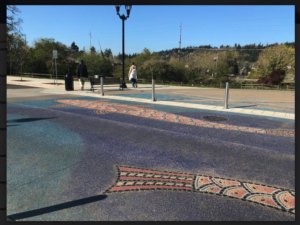 steps leading down to a small unpaved path that leads to a hidden view of Kellogg Creek and any ducks, mammals or
steps leading down to a small unpaved path that leads to a hidden view of Kellogg Creek and any ducks, mammals or
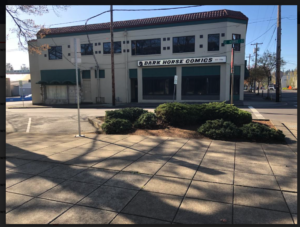 other birds that like this secluded habitat. While the first side trip to Klein Point Overlook is all paved, this little stop is not. For those with balance and walking concerns, be careful here.
other birds that like this secluded habitat. While the first side trip to Klein Point Overlook is all paved, this little stop is not. For those with balance and walking concerns, be careful here.
As it has been mostly a downhill and horizontal walk so far today, the aerobic walk up the SE 26th Street hill comes as a bit of a surprise to our gluteus maximi resulting in an end to the interesting chatter due to an increase in the aerobic breathing sounds that begin. We try to 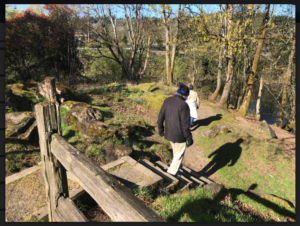 get a hill or two in on each walk, an uphill. Perhaps in the future we should write about “hill walks” in our nearby areas.
get a hill or two in on each walk, an uphill. Perhaps in the future we should write about “hill walks” in our nearby areas.